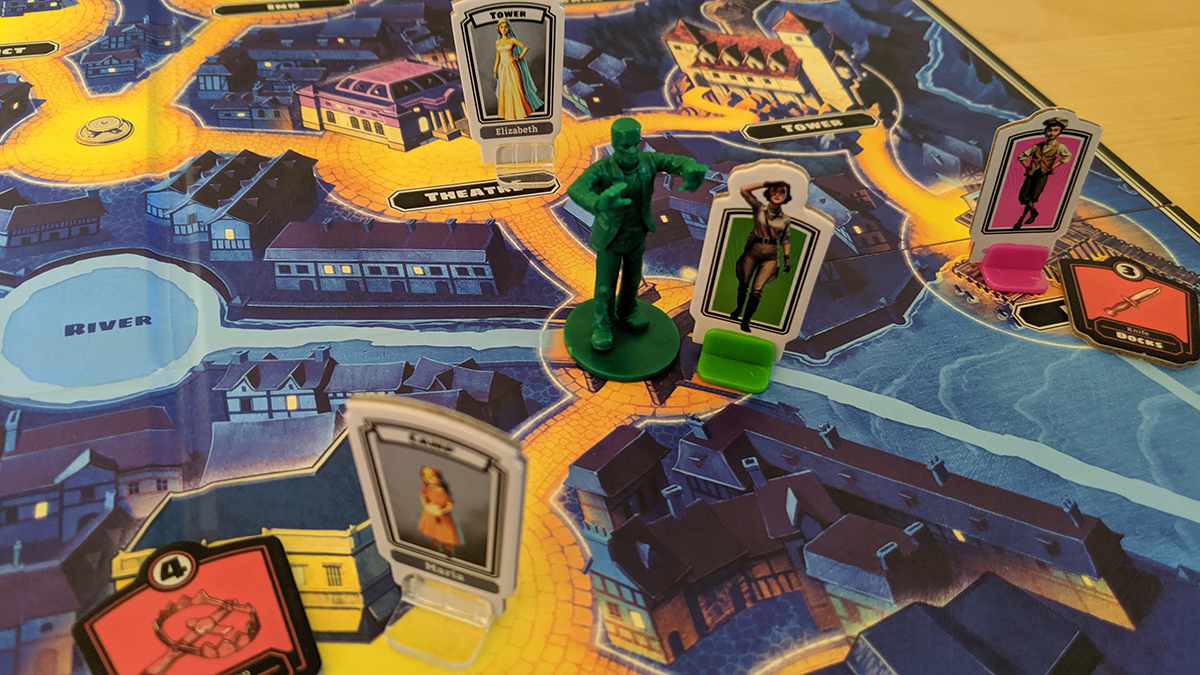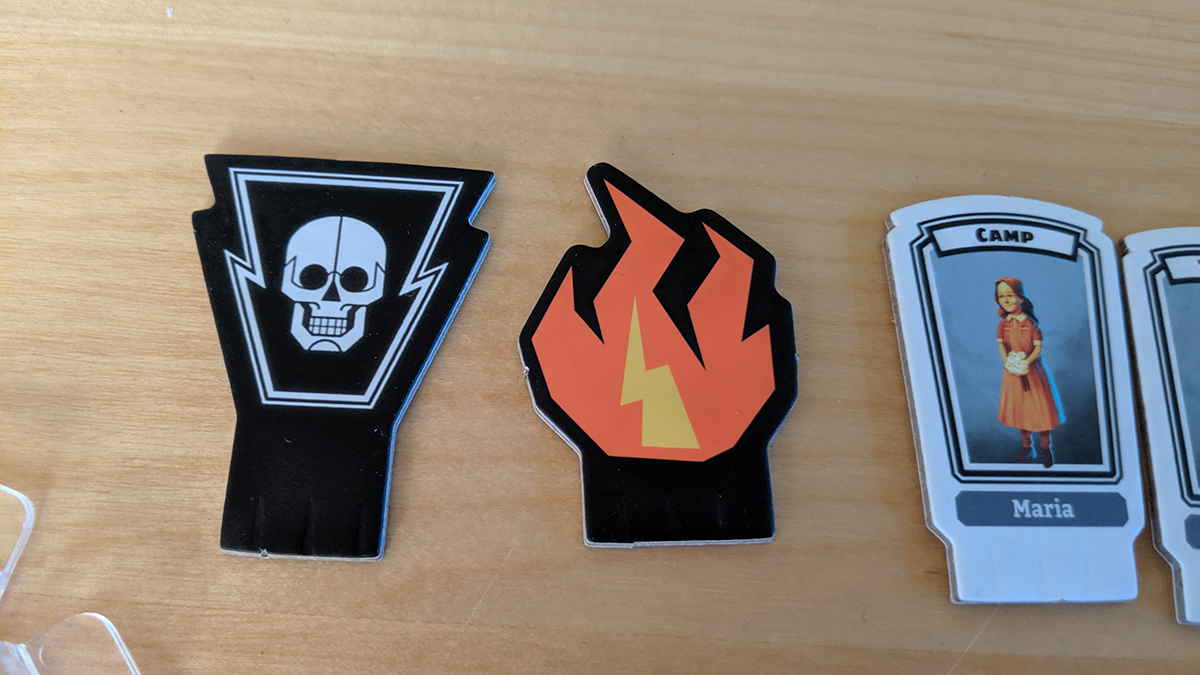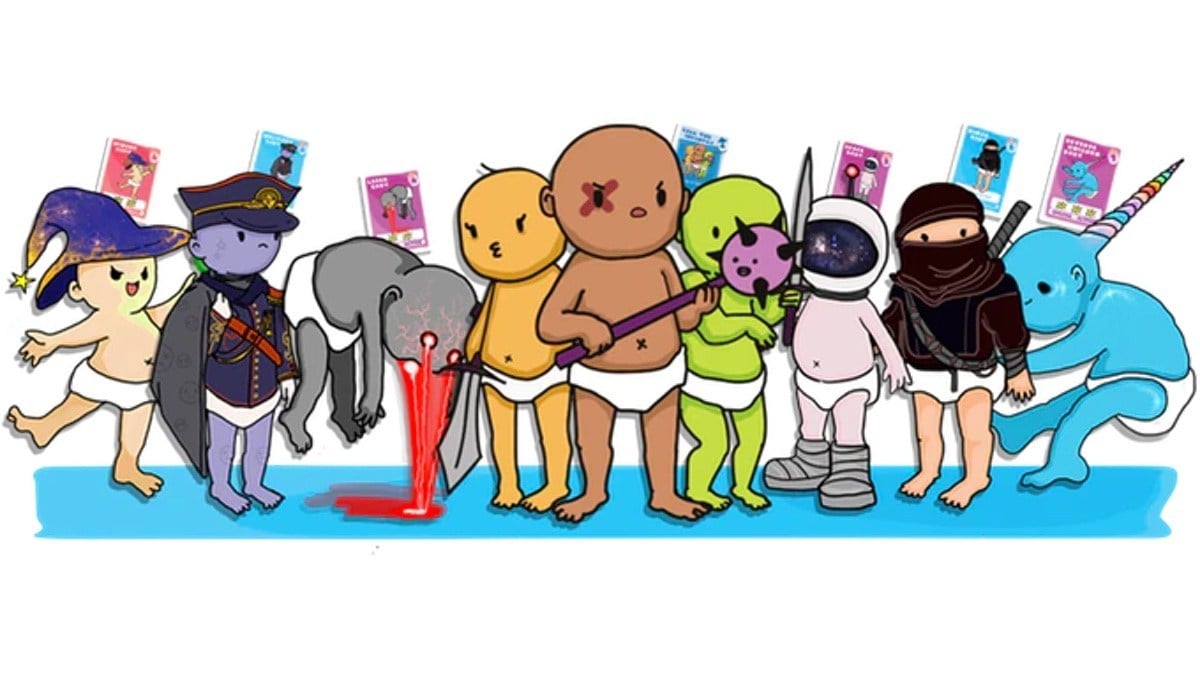 Universal’s planned series of remakes feauring its classic monsters may be struggling to get off the ground, but it’s licensed board game by Ravensburger is a certain hit. I can’t say for certain whether it’s the innovative gameplay, or merely the fact that the game doesn’t star Tom Cruise, but for whatever reason, if this is the thng that keeps the Creature from the Black Lagoon and the Wolf Man in the popular consciousness, then mission accomplished.
Universal’s planned series of remakes feauring its classic monsters may be struggling to get off the ground, but it’s licensed board game by Ravensburger is a certain hit. I can’t say for certain whether it’s the innovative gameplay, or merely the fact that the game doesn’t star Tom Cruise, but for whatever reason, if this is the thng that keeps the Creature from the Black Lagoon and the Wolf Man in the popular consciousness, then mission accomplished.
What Is Horrified?
Horrified is a game for 1-5 players, ages 10 and up, and takes about 60 minutes to play. It’s currently available exclusively from Target for $34.99.
Horrified Components

Included in the box are:
- 1 Game Board
- 6 Monster Mats
- 7 Monster Figures
- 7 Hero Badges
- 7 Hero Movers
- 10 Villager Movers
- 60 Item Tokens
- 1 Frenzy Token
- 1 Terror Marker
- 1 Item Bag
- 5 Reference Cards
- 3 Dice
- 30 Monster Cards
- 20 Perk Cards
- 1 Boat Token
- 1 Camp Overlay
- 6 Scarab Tokens
- 1 Soul Sign Token
- 1 Museum Overlay
- 4 Coffin Tokens
- 1 Frankenstien Dial
- 1 Bride Dial
- 1 Precinct Overlay
- 1 Hunted Emblem Token
- 1 Cure Token
- 1 Laboratory Overlay
The components are all of very high, finished quality.
The board is about 2 feet square, and laid out with a series of buildings from a “village” that is unfortunate to be beset by a series of classic Universal monsters: Dracula, the Creature from the Black Lagoon, the Mummy, the Wolf Man, the Invisible Man, and Frankenstein and Bride of Frankenstein.
Note: Let me digress for a moment and head off any “well actually” comments: the rulebook freely acknowledges that the monster isn’t Frankenstein. But, let me just quote directly:
“Frankenstein is actually the name of the scientist who created these Monsters. However, with so many Monsters plaguing their village, the villagers have come to refer to these particular Monsters as just ‘Frankenstein’ and the ‘Bride’.”

Each Monster is represented by a plastic Monster miniature. While they are each a single color, they have a surprising amount of detail. And each is distinct enough that you’re unlikely to get confused who is who.
Pretty much everything else is cardboard, but maintain a level of both design consistency and detail to make for a very pretty game.

The Hero Badges are large pieces that provide all of the needed information for each player, including the number of actions allowed, the color, and the character’s special ability. The matching (but much smaller) standees are color-coded twice, in the background of the art and the colored plastic stand, making it easy to find your character on the board.

The Monster Mats are made from heavy paper rather than cardboard, but they’re nice and big and provide both an easy reference to the things the monster does, along with a play area for tracking the players’ progress towards defeating the monster. A nice touch is that the back of each of the Monster Mats contains the setup instructions for all of the monsters, so you can use one of the ones you aren’t using in the current game to help setup.

Each monster plays a bit differently, and has different victory conditions. This provides a lot of replayability, but posed a design challenge. How do you not clutter the board up with a bunch of information for a monster that isn’t in the game? The solution here is done very nicely: each monster has a set of additional tokens used only when it is in play. Four of them add overlays to the board, covering the generic space with a more detailed one for that monster. The overlay is the only additional component needed for the Invisible Man. The Creature has an overlay and a boat token that is used on its playmat. Dracula has four coffin tokens that must be destroyed by the players. Frankenstein and the Bride have dials for their playmats.

The Wolf Man adds an overlay, along with a Hunted Emblem that may be acquired by a player and a Cure token. The Mummy has an overlay, a Soul Sign, and six Scarab tokens that must be unscrambled on its Monster Mat.

The Item Tokens were the one somewhat disappointing element. There are sixty of them, divided into three colors (red, blue, and yellow). Each has a location, a picture and name, and a strength. There’s nothing inherently wrong with those, but as we played the game we realized that the name and art of the items was essentially flavor text and had no bearing on gameplay. You simply need X combined strength of Y color tokens against most of the monsters.
How to Play Horrified
The Goal
The goal of the game is to defeat two, three, or four (depending on the desired difficulty) monsters before they kill a certain number of villagers or heroes or before you run out of Monster cards.
Setup

Place the board on the table. The Terror Marker is placed on the “0” spot on the Terror Level Track. The Villagers and dice are placed next to the board. The Monster cards and Perk cards are shuffled individually and placed next to the board.
Then, the players choose how many and which monsters to face. The rules suggest that you use Dracula and the Creature for the first (easy) game, any two random monsters for a novice game, three monsters for a standard game, and four monsters for a challenging game.

The monster setup depends on the monsters being used, which is detailed on the back of each of the Monster mats.
Once that is done, players choose their characters. This can be done randomly, or players can select the characters whose abilities will give them the best chance at defeating the chosen monsters.

Each player is then given one Perk card.
Finally, the 60 Item tokens are shuffled and put in the bag. Twelve are drawn at random and placed on the location indicated on the token.
Gameplay
Each round is played in two phases.
The Hero phase is when the players move and try to accomplish tasks. Players may choose to go in a different order each round. Heroes have 3, 4, or 5 actions they may take, depending on the character. They can perform any of their actions in any order, and may take the same action more than once.
The first possible action is Move, where you move one space on the board. As all actions can be taken more than once, you can move up to the total number of actions your character has. If you are in a space with villagers, they can move with you.

You can also Guide villagers, where you can move one villager from the Hero’s space to an adjacent space, or move one villager from an adjacent space to your space. Moving villagers is important both to keep them away from the monsters and to get them to their desired locations (printed on their standees), which is the only way for players to get additional Perk cards.
Heroes can pick up any number of items in their space as an action. They can also take an action to share any number of items with another Hero in their same space.

Heroes can use actions to fight the Monsters. Heroes can take an action to advance a Monster’s task. For example, a Hero on a space with a coffin can spend the required items to smash it when playing against Dracula. If the Heroes have advanced the Monster’s task to its end point and are in the same space as the Monster, they can use an action to defeat the Monster.
Finally, Heroes can use their Special Action, which varies amongst the characters.

Once all of the players have completed their turn, the Monster phase begins. This is pretty simple: draw the top card of the Monster deck and do what it says.
Each card has a number at the top. Players draw that number of items from the bag and place them appropriately on the board.
Then, there may be an event. As I mentioned above, in designing the board the game’s designers decided against going for an all-for-one approach and instead use the Monster-specific overlays and items. They didn’t take this approach with the cards, so very often you will draw a card that calls for an event for a Monster not in play. In those cases, you simply ignore the event and move on.
Finally, the monsters attack. At the bottom of each card is a diagram that shows which monsters will attack this turn. As with the events, it’s possible that players will get lucky and draw cards that have monsters that are not in play attack. However, if the monster is in play, it will move an indicated number of spaces and then attack any Heroes or villagers in the space it ends up in.

Attacks are pretty straight-forward: roll the indicated number of dice. If the hit symbol, which is on 3 of the 6 sides of the dice, is rolled, the Monster scores a hit. If the blank is rolled, nothing happens. If the final symbol–the exclamation point–is rolled, then the Monster’s special power is activated.
Villagers are immediately killed on any hit by a Monster in their space. The killed villager is removed from the board, and the Terror track is increased by one.
Heroes are likewise killed on a single hit, but they can deflect the hit by choosing to discard items instead. Again, the generic nature of the items rears its head again here, as any item can be used to deflect any hit. Players may discard as many items as needed.
If the player cannot discard items, or chooses not to, they are hit. But, they aren’t killed. Instead, they immediately move to the Hospital, where they will begin their next turn. There will be times when players will decide it might be more strategic to hold on to items and let a Hero be hit. However, this does raise the Terror track.
If there are both villagers and a Hero in a space, the Monster will always attack the Heroes first.
Game End
The game ends when all of the Monsters are defeated, at which point the players win. However, if the Terror Marker reaches the end of the Terror Track, or the players run out of cards in the Monster deck, then the game ends with a victory for the Monsters.
Why You Should Play Horrified
The first time my son and I played the game, using the recommended First Game setup of playing against Dracula and the Creature, we were disappointed. We’ve played enough cooperative games that we know how to work together, and we felt that it was just too easy. We defeated both monsters while hardly taking any hits.

I had some trouble convincing him to play again, but did manage to get my son to give it another try. This time, we took on three random monsters–the “Standard Game” setup. And not only was the game much more challenging, but it was a lot more fun. We lost, but lost the way we should in a well-designed cooperative game, where we only needed one or two more turns to win.
So, this is definitely a case of needing to try the game more than once. I might even go so far as to suggest that you ignore the rulebook and not start with that Dracula-Creature setup. We haven’t had a chance to revisit the game to see if any two creatures are too easy or if it’s just those two, but I’d definitely recommend starting with the “Standard” setup against three monsters.
The game’s variability and the very different ways each Monster plays ensures that the game won’t get stale. It’s definitely a fun addition to the cooperative genre, and hopefully will be more successful in keeping Universal’s Monsters in the cultural zeitgeist than the movies.
You can pick up your copy from your local Target store.
Click here to see all our tabletop game reviews.
![]() To subscribe to GeekDad’s tabletop gaming coverage, please copy this link and add it to your RSS reader.
To subscribe to GeekDad’s tabletop gaming coverage, please copy this link and add it to your RSS reader.
Disclosure: GeekDad received a copy of this game for review purposes.




